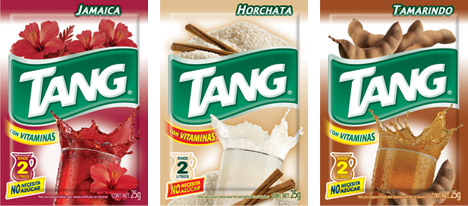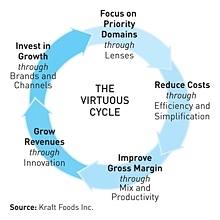
How an unusual management technique inspires business teams to envision — and achieve — breakthrough results.
strategy+business magazineby Sanjay Khosla and Mohanbir Sawhney
Illustration by Jack Unruh
 |
| English: (Photo credit: Wikipedia) |
In 2007, Kraft Foods Inc. was facing a major challenge with Tang — the powdered breakfast drink that had long been one of its iconic brands, made famous in the 1960s when the National Aeronautics and Space Administration included the drink in the rations for U.S. astronauts. The brand was caught in a cycle of underperformance … In 2007, the leadership team of Kraft’s developing markets identified Tang as one of their top 10 focus brands, and came up with an unusual strategy for boosting the brand’s sales …: Tang leaders in key countries such as Brazil were given a “blank check,” essentially urging them to dream big and not worry about resources. The results have been astounding. In the last five years, Tang has doubled sales outside the U.S. and become a profitable, US$1 billion brand there (in comparison, it had taken Tang 50 years to reach the $500 million revenue mark). …
 |
| IN SPACE - JULY 15: In this handout image provided by the National Aeronautics and Space Administration (NASA), Expedition 28 crew and the STS-135 Atlantis astronauts (L-R, front) NASA astronaut Mike Fossum, NASA astronaut Chris Ferguson, Russian cosmonaut Andrey Borisenko and NASA astronaut Ron Garan; (L-R, middle) NASA astronaut Sandy Magnus and Russian cosmonaut Alexander Samokutyaev; (L-R, back) NASA astronaut Doug Hurley, NASA astronaut Rex Walheim, Russian cosmonaut Sergei Volkov and JAXA astronaut Satoshi Furukawa pose for a portrait aboard the orbiting complex's Kibo laboratory of the Japan Aerospace Exploration Agency on the International Space Station July 15, 2011 in space. Space shuttle Atlantis is on the last leg of a 12-day mission to the International Space Station where it delivered the Raffaello multi-purpose logistics module packed with supplies and spare parts. This was the final mission of the space shuttle program, which began on April 12, 1981 with the launch of Colombia. (Image credit: Getty Images via @daylife) |
… We believe that business leaders can unleash tremendous untapped potential by unshackling their people and their businesses from resource constraints (while still, of course, holding them accountable for results). The key insight is that business leaders, … should focus on defining ambitious goals, while leaving it to their managers and their teams to ask for whatever resources they need to achieve these goals. When teams decide their own budgets, they act as owners and are inspired to achieve the impossible. At Kraft Foods (where coauthor Sanjay Khosla is president of the developing markets group), we call this idea a “blank check” initiative.
The Concept of a Blank Check
A blank check is a metaphor for the freedom a team is given to determine for themselves the financial resources they need to achieve a set of agreed-upon goals within a defined time frame. … However, blank checks are not a license to spend without limits, without guidelines, or without consequences. Teams have to define the resources they need — they must fill in the amount of the blank check. Every blank check initiative needs to be consistent with the company’s overall business strategy. And it needs to have the potential to produce sustained, profitable growth. (See “Driving the Virtuous Cycle of Growth.”) Blank checks are not meant to produce “one-hit wonders” ... The idea of the blank check is to empower big ideas that drive a virtuous cycle and change the business’s trajectory for the long term.Moreover, teams that sign up for blank checks are held strictly accountable for quantifiable results. Blank checks represent freedom within a framework ... For example, the framework might include a set of company priorities or areas of focus, innovation platforms, big bets, or even an acquisition strategy that guides the company’s overall strategy or vision. At Kraft Foods, for example, the company’s developing markets business has a focused growth strategy that concentrates on five key categories (e.g., biscuits and chocolate), 10 power brands (e.g., Oreo, Tang, Trident, and Cadbury), and 10 priority markets (e.g., Brazil, India, and China); the strategy is called 5-10-10. (See “Growth through Focus: A Blueprint for Driving Profitable Expansion,” by Sanjay Khosla and Mohanbir Sawhney, s+b, Autumn 2010.) The company uses this strategy as its framework, and gives freedom to select teams in the organization to drive the 5-10-10 growth agenda with blank checks.

Tang’s localized flavors are boosting sales. Photographs courtesy of Kraft Foods Inc.
How Blank Checks Work
To put the blank check idea to work, business leaders need to go through a systematic process of picking the best bets, selecting the team, defining goals and plans, kicking off the initiative, and monitoring the results. Here’s what happens at each of these five steps.1. Picking the best bets. The first step …is … to choose the business domains that should be targeted for growth. … Business domains can be defined in different ways or viewed through different lenses — a geographic market (China, for example), a brand (Tang), a channel (food service), a category (beverages), or a consumer segment (teenagers). …We recommend selecting two or three definitions for the domain, at most, and using these definitions to shape the larger strategic context within which to look for blank check projects. The objective is for the initiative to be performance-driven and values-led ...
As the business leaders choose the domains for the blank check initiatives, they need to keep three criteria in mind …“the three Ms.” First, the business should ideally have significant Momentum. It is always easier to build on a business domain that is working well than to fix a domain that is broken. ... A second key success factor for driving a virtuous cycle of growth is Margin potential in the business. ... Third, the business initiative should be Material — something that produces high impact with the least possible effort. …
2. Selecting the team. Blank checks are ultimately bets on people, ...
Team leaders selected for blank check initiatives need not be the most senior or the most experienced — more important is for them to be the people with the most potential. …
The business leaders must ask themselves a series of questions about the blank check candidate. Is this person a natural choice for the challenge based on his or her current responsibilities and span of control? Will this person be willing to take on the responsibility and not be frozen by fear? Is this person capable of being stretched to think in new ways? Does this person have the capacity to inspire others to do things differently? Does this person have a track record of delivering results? … And if one cannot be identified, leaders may determine that the area of the business they were targeting is not appropriate for a blank check.
3. Defining goals and plans. … Targets need to be quantified, aggressive, and time-bound. Quantified targets are unambiguous, so everyone clearly understands the nature and goals of the game. Targets should be measurable on well-defined metrics like revenues, gross margins, and cash flow from the business.
Targets also need to be aggressive, to the point that they should not be achievable simply by making incremental improvements. Teams should be forced to question all their assumptions about their business and to confront orthodoxies that have been blindly accepted by the company. Blank check initiatives also need to have a short time frame, limited to a few years at most. It is absolutely essential to have a clearly defined set of goals for the first 12 months. The short time frame forces the team members to produce results quickly. …
At this stage, the team leaders are asked to submit a short business proposal … that reflects the three Ms.
The time given to the team to develop the proposal is relatively short. This prevents the team from becoming paralyzed by overanalysis. …In a few cases, the team will decide to turn down the blank check. This is fine, because undertaking a blank check initiative must always be voluntary.
The business proposal needs to define the initiative and the key steps that the team will take to produce the agreed-upon results. This includes … steps detailing how the plan will be executed, key milestones and deliverables, and financial projections. At the early proposal stage, the initial execution steps may be outlined, but the full project need not be fully fleshed out.
Along with the proposal, the team also must fill in the amount of the blank check — the financial outlay that they are asking for. … The amount should be more than enough for the team to carry out the initiative without worrying about running out of money to invest.
4. Kicking off the initiative. Once the business plan has been agreed upon, business leaders need to formally “issue the check” by approving the amount the team has asked for and transferring it into an account that can be accessed by the team leaders.
The typical first reaction to a blank check challenge is skepticism. … Once the team realizes that their business leaders are serious, skepticism can easily give way to fear — fear of failure and fear of being in the spotlight. Fear is often followed by frenetic activity, when the team tends to focus on doing more of the same or doing the same things better. But the team quickly realizes that this linear and extrapolative thinking will not produce the breakthrough results that they need to achieve. This, in turn, leads the team to powerful insights because they are forced to focus on the essence of the business, the brands, and the market.
5. Monitoring results. As the blank check initiative begins, it is important to set milestones for key deliverables, and then to monitor them closely as the initiative proceeds. … As is true of a company’s startup phase, blank check initiatives rarely go according to plan. The team will run experiments and take risks, and some of these experiments will inevitably fail. Failing is part of the learning process. What is important is to fail early, fail cheaply, and learn fast from the failures. Metrics for blank check initiatives should be kept simple enough so that progress can be measured on a single-page report. …
Dealing with Failures
Blank checks produce spectacular results when they work. However, … a certain percentage of them will be unsuccessful. Business leaders need to be prepared for some of these initiatives to fail. There are two important lessons in dealing with failures — learn from the failures and overcome the fear of failure.Kraft’s Royal affordable nutrition program in Latin America is an example of how to deal with a blank check initiative that doesn’t work out. Kraft believed that there was a large opportunity to drive growth at the “bottom of the pyramid” by developing nutritious yet affordable products for low-income Latin American consumers. … However, the products failed to sell well, and the gross margins were lower than expected. Kraft decided to pull the plug on this initiative.
The team learned many important lessons from this failure. The product involved changing consumers’ attitudes and behavior — a difficult and lengthy process. … And the business model was not sustainable: Costs were too high, and the company could not meet the affordability target it had set while still earning an acceptable gross margin. Importantly, the team leading the initiative was not penalized; the team leader was promoted to head the snacks business in Brazil despite the failure, because he took a risk and then learned from his mistakes.
Tips for Managing Blank Checks
Through our experience with several blank check initiatives in different product categories and markets, we have identified some important principles for improving the odds of success.Focus on what matters. … In the case of Kraft Foods, blank checks are linked to the company’s “winning through focus” strategy, which allocates resources in line with its 5-10-10 strategy.
Create a virtuous cycle of growth. …Business leaders should be careful that teams don’t undertake initiatives that can boost revenues in the short term but that will hurt the business in the longer term. To ensure sustainable profitable growth that drives a virtuous cycle, blank check initiatives need to be gross-margin accretive. Margin expansion can come from increased revenues, from cost reduction, or from productivity improvement.
Innovate broadly. To harness the full potential of their business, teams need to take a broad view of innovation that goes well beyond creating new products. They need to innovate with packaging, promotions, advertising, distribution, and partnerships.
Simplify everything. … Complexity adds cost and slows down decision making. … Simplification can be achieved in the product (for example, by reducing performance or features to “just enough” levels desired by consumers), in the process (manufacturing, distribution, sales), in the organization (removing layers and moving decision making closer to local markets), and in administration (faster decision making and fewer meetings).
Don’t overdo it. … Blank checks are powerful tools, but they are very demanding in terms of both financial resources and leadership bandwidth. They will produce revenue and profit increases in the long run, but they require significant investments in the short term. They also require a lot of personal attention from business leaders. Just as venture capitalists limit the number of startup investments they make and the number of company boards they serve on, business leaders need to limit the number of blank checks they issue simultaneously.
Create a family spirit. Blank check initiatives require every team member to put the collective good of the team above his or her ego and personal point of view. … This attitude can be fostered by adjusting incentives so that team members win when the team wins as a whole. It also helps to host “family dinners” before every major leadership team meeting. Each dinner has a clear agenda focused on two or three business issues that need input from the family. At the end of the dinner, the team arrives at a consensus on the business issues. This practice gives the team clarity on what they need to do and also promotes a sense of shared ownership of the outcomes.
Driving Organic Growth
It is not easy to find profitable organic growth. Faced with stagnant demand, intensifying competition, and greater pricing pressures, business leaders feel that their growth is constrained by the environment in which they find themselves. However, the constraints are sometimes of their own making. Even seemingly sleepy businesses hold tremendous untapped potential. If business leaders can liberate their people from the limitations of budgets and resources, they will find that their people will surprise both leaders and themselves with what they can achieve. This is the power of blank checks.Driving the Virtuous Cycle of Growth
Although blank checks are designed to create a step change in the growth of a business, it is important that the growth in revenues and profits is lasting. … [True] shareholder value is created when the profitable growth is sustained over the long term.

To ensure that blank checks produce durable profit and revenue growth, it is important to embed the blank check initiatives within a well-defined process that ensures checks and balances on the initiatives. We call this the Virtuous Cycle of Growth. The virtuous cycle is based on a seemingly simple insight — the more you grow revenues and cut costs, the more resources you have available to invest in future growth. The essence of the virtuous cycle is that growth generates resources that drive more growth. The virtuous cycle consists of five steps; each step emphasizes an outcome and the means to achieve the outcome. These steps need to be followed rigorously to ensure that blank check initiatives remain on track.
— S.K. and M.S.
Author Profiles:
- Sanjay Khosla is president of developing markets at Kraft Foods Inc.
- Mohanbir Sawhney is the Robert R. McCormick Tribune Foundation Clinical Professor of Technology and director of the Center for Research in Technology & Innovation at the Kellogg School of Management at Northwestern University.









No comments:
Post a Comment